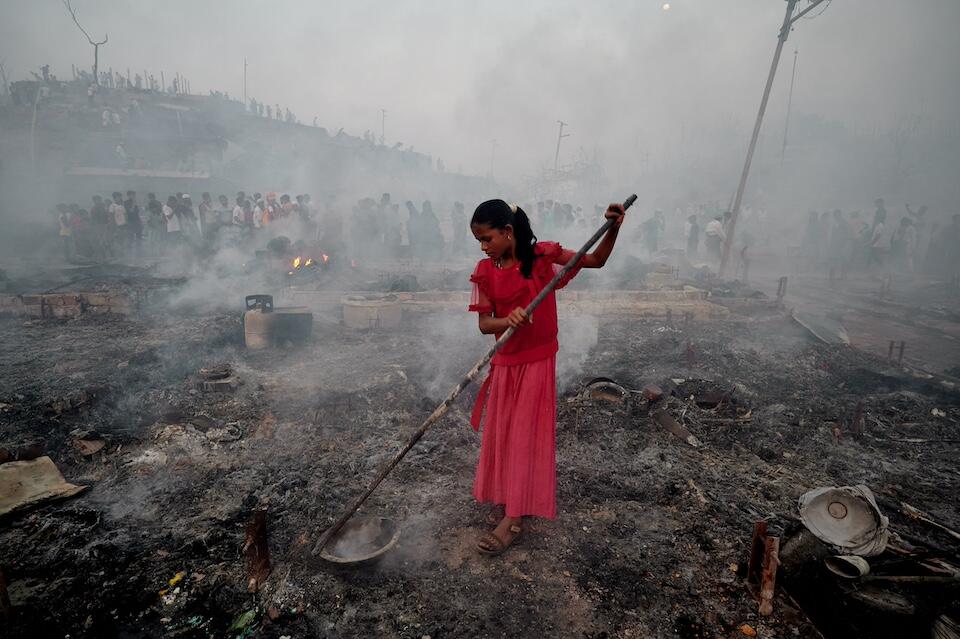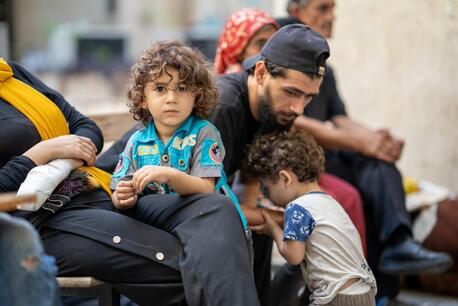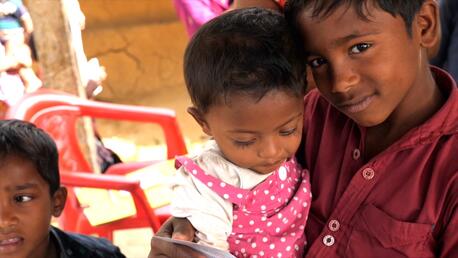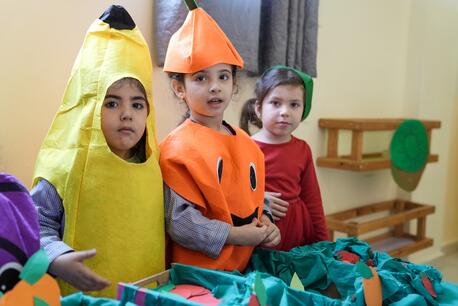Inside Look: How UNICEF Supports Rohingya Refugees in Bangladesh
In late August 2017, in a matter of days, roughly 700,000 Rohingya refugees fled brutal violence in Myanmar for Bangladesh, joining the few hundred thousand already there. Their chief concern: survival. Seven years into the Rohingya refugee crisis, there are still 1 million refugees living in sprawling camps, their bamboo shelters regularly battered by storms and other climate shocks, entirely dependent on humanitarian aid.
UNICEF has maintained an active and continuously evolving presence on the ground since Day One, delivering water and sanitation, nutrition, education, health and child protection, alongside the government and other partners. UNICEF USA recently connected with Sayed Ezatullah Majeed, Chief of the UNICEF Field Office in Cox's Bazar, for a deep dive into how UNICEF is managing what has turned into a protracted emergency, and the importance of flexible funding from donors to ensure efficiency and maximize impact for children.
Q: Please provide a brief summary of the situation, and what happened to get to this point.
SAYED EZATULLAH MAJEED: We have about 1 million Rohingya refugees living in Cox’s Bazar, Bangladesh, and UNICEF, alongside a number of partners, has been providing emergency relief, humanitarian assistance without interruption, for the past seven years.
Some of the Rohingya refugees have been here for more than three decades, but their numbers are small. Most refugees in Cox’s Bazar, and the 34,000 or so that have been relocated to the nearby island of Bhasan Char, were part of the big influx of August 2017.
Our main partner is the government of Bangladesh. With the recent changeover, we are working steadfastly with the interim government to make sure services and support for the refugees continue uninterrupted.
Q: How did recent political turmoil, with the protests and the violent response, where hundreds of people lost their lives, including children, affect UNICEF’s humanitarian assistance operations?
SAYED EZATULLAH MAJEED: As our regional director [for South Asia, Sanjay Wijesekera] has said, UNICEF is deeply concerned about the impact of recent violence in Dhaka. Children must be protected at all times, and this is everyone’s responsibility.
What I can tell you — and this is not part of the Rohingya response, but rather the Bangladesh country program — is that there is a UNICEF-supported helpline for children staffed by trained counselors, who listen to children’s concerns and refer them for support or services as needed and also follow up with them.
One of the best ways to help children recover from violence and to keep them safe is to keep them in school, because the longer children are out of school, especially girls, the less likely they are to return, and that puts them at all kinds of risk. UNICEF is supporting the return to school for children all across Bangladesh — children who have had to miss school due to cyclones and floods, and children who have missed school due to the unrest. Those efforts are ongoing.
Q: What are your greatest challenges to meeting the needs of Rohingya children, safeguarding the rights to protection, health, education, etc.?
SAYED EZATULLAH MAJEED: The impact of climate change is huge. The Rohingyas are living in very congested camps that are vulnerable to flooding, landslides and cyclones, which are very common in Bangladesh. This issue doesn’t just affect the Rohingya refugee camps, it affects the host communities as well, but the camps are on the coast of the Bay of Bengal, so they are more exposed. These climate impacts basically create an emergency within the emergency. You already have dire needs in the camps where the refugees are living, and then suddenly a flood comes, or a landslide, or a cyclone.
Fortunately we are able to stay agile. We have the ability to expand a program or shrink it down as needed, to redeploy or shift resources as needs change, and that has helped us to be more effective on the ground. Flexible funding is one of the keys for success in UNICEF programming. I am very grateful to those donors who have contributed to the flexible fund. You cannot always predict the long-term needs.
Of course, humanitarian funding overall is down, so we all have to do more with less. This is where flexible funding becomes even more crucial. Most of the funding we receive from the U.S. Government, from American taxpayers, is unrestricted, and that funding lets us respond to needs quickly.
Q: There are many UN agencies and NGOs on the scene, delivering for Rohingya children and families. What is UNICEF focusing on?
SAYED EZATULLAH MAJEED: UNICEF is the lead agency for education, water, sanitation, nutrition, and also child protection. We coordinate closely with those other agencies and are constantly improving how we do this or that, to maximize efficiencies and impact for children. Whether it is a health package [of services] or nutrition or education, we are continuously reviewing: What is the cost per child and how can we make it better, more efficient and more effective.
Q: How have your strategies changed or evolved over the years?
SAYED EZATULLAH MAJEED: We have found that the more volunteers we can enlist from the Rohingya community, the better. For example, in nutrition programs, we have trained volunteers to help screen children for malnutrition, train parents and caregivers to monitor their children’s nutritional status and to seek out services as needed.
We have volunteers for health, for child protection, for water and sanitation and for education as well. Almost half of the 9,000 teachers who provide education for Rohingya children are Rohingyas that are trained as education program volunteers. Initially their roles were limited, but as we scaled up the rollout of the Myanmar curriculum, the functions and roles of Rohingya facilitators and teachers significantly increased.
We are building the capacities of the Rohingya, training them to become the service provider. We call them volunteers, because they are not permitted to work in the country. But they are paid by UNICEF and other UN agencies and NGOs. They are receiving some remuneration, some incentive. And in many cases the volunteers are the backbone of the program.
This is incredibly important when things happen that prevent members of the international community, whether it’s the UN or an NGO affiliate, from going into the camps for an extended period of time. So these volunteers are really helpful, by maintaining the programs inside the camps.
We saw this during COVID-19. The humanitarian community had limited access to the camps and lifesaving essential services were delivered by Rohingya volunteers.
Q: Is there any hope of returning to Myanmar?
SAYED EZATULLAH MAJEED: Let’s look at the bigger picture. The Rohingyas' living situation inside the camps is not good. The conditions which are put on them, the exposure. Livelihood activities are not allowed to a large extent, so income levels are almost zero. Rohingya refugees are 100 percent relying on the international community for support. That is not an acceptable situation for them to stay [in].
All the shelters are made of bamboo, which is a sturdy material. We are not allowed — neither the UN agencies nor the NGOs — to give them proper shelter. It was the decision of the high authorities of the government of Bangladesh that no permanent structure can be built inside the camps. Whatever structure is there must be temporary. On the other hand, the situation at the other side of the border is very bad, with active fighting ongoing, so at this stage it is not safe at all for the Rohingyas to think about going back to their homes.
The temporariness of all structures — including shelters, learning centers and service points that are made from bamboo — greatly impacts programming. These structures don’t last. Within two years it is in need of repair; after four years, you need to redo it. And that’s just regular wear and tear. The moment there is a cyclone, the moment there is heavy rain, the moment there is a strong wind, you have hundreds of these shelters and facilities getting damaged, and the process of repairing them is not easy. It takes time and costs a lot.

And unfortunately, we also have lots of fire incidents. Families cook inside their shelters using gas cylinders. They use the same thing for heating in winter. A small fire during the dry season will quickly spread. We’ve had two very bad experiences with this, when a fire started in one camp, and within the hour more than 10,000 shelters had burned, 8,000 of them completely destroyed. We also lost many learning centers and a few health centers.
So the bamboo temporariness of the shelters, combined with these climate change-related disasters, are exposing Rohingyas to a next level emergency and humanitarian situation. Seven years into this crisis, we are looking at a protracted emergency, one that requires more long-term planning and long-term thinking.
The bamboo temporariness of the shelters, combined with these climate change-related disasters, are exposing Rohingyas to a next level emergency and humanitarian situation.
Q: How has this shift affected education programs for Rohingya children?
SAYED EZATULLAH MAJEED: In the beginning we talked about numbers — how many children we had coming into the learning centers. Now we talk more about the quality of the education they are receiving. We are looking more at teacher training, and building their capacities to deliver quality.
In late 2021, we introduced the Myanmar curriculum as pilot, then for the 2022 academic year we scaled it up. This was an ask from the community, from the caregivers and caretakers and from the children. It helped the children to build on the education they had already received in their country, and it prepares them for when they eventually go back, so they can continue learning on the same curricula.
We took the curriculum of Myanmar and reprinted the textbooks [for distribution]. There are more than 332,000 children involved in the education program.
Q: I imagine a key difference is that the instruction is in Burmese. What are some other differences?
SAYED EZATULLAH MAJEED: While the textbooks are in Burmese, the medium of teaching is a mix of Burmese, Rohingya and English languages. The history subject is focused on Myanmar. Geography, English and mathematics are about the same, but the requirements or methods of teaching may vary. The idea is to ease the process of student learning, to follow methods they are already familiar with, those who received some schooling before they became refugees.
Q: How do you find space for schools in the camps?
SAYED EZATULLAH MAJEED: The schools — we call them learning centers — came a little later. There was no space to have a bigger school, with 10 or 20 classes and multiple grades. We have one class here, another class maybe 200 meters away. Maybe there’s a slightly larger space 500 meters away where we can have four classes together. There are more than 3,500 learning centers across the camps.
In addition, the shelters of refugees are also being used, and when a refugee shelter is being used as a learning center, we call it a community-based learning facility. These are used mainly for the education of adolescent girls and for the younger kids, the 4- and 5-year-olds going to kindergarten.
Parents and caregivers are happily sending their young child to kindergarten when it is within five minutes walk from their shelter. If the facility is far away, many parents don’t feel comfortable to send their young child for learning.
And in Rohingya culture, when girls reach puberty they are often restricted from going out of the house, and from many social activities, so having a classroom for girls' education on the same block where the family lives gives caregivers confidence that it will be OK for the girls to attend class. Having learning centers everywhere makes life easier — makes accessing education easier — and we have higher enrollment.
Q: Are we talking about one big camp? Or lots of small camps adjacent to each other?
SAYED EZATULLAH MAJEED: Cox's Bazar district has eight sub-districts. Only two sub-districts host refugees. All the camps are concentrated in those two sub-districts. There are 33 camps, with a total population of around 1 million; 23 of them are adjacent to each other, and they are interconnected like one mega camp.
A few of the other camps are 2 to 10 kilometers down the road. There are smaller camps with a population of 9,000, and there are bigger camps of 53,000 to 55,000 population.
Each camp has four or five blocks — blocks A, B, C and D, some of them have a block E, maybe a block F. Each block has couple of sub-blocks. So a person can identify himself, "I am living in Camp 5, Block A, Sub-block 3."
Q: Let’s talk about WASH. How do you provide water, sanitation and hygiene (WASH) services and support when nothing permanent can be built?
SAYED EZATULLAH MAJEED: UNICEF is the lead agency on WASH, and starting in 2025, we will be providing services to half the refugee population in Cox’s Bazar. That’s a big increase; we're almost doubling our area of service coverage.
The water network, which is supported by UNICEF and WASH partners, consists of some deep wells, solar-powered water pumps, a reservoir and networked water collection points close to the refugees’ shelters. Water is provided for two hours in the morning and two hours in the afternoon; more than 20 liters of water per individual per day. About 20 percent of the refugees collect their water from a hand pump.
There is a water distribution point for every 30 – 40 houses, so nobody has very far to walk. And each point has multiple taps, so five, six, seven people can collect water at the same time. In a hot climate, we cannot keep a woman or a child or a man waiting for half an hour to collect water. We have all water collection points mapped. UN agencies contract local NGOs to handle maintenance and repairs, but we are accountable and responsible for the water supply network that we built.
There is no proper sewage system. The whole network is set up to be temporary. It is not an investment in infrastructure like you would do when building for a town or city. So there are maintenance costs. And day-to-day operating costs are high. Unfortunately, the water sector is among the least funded.
Q: So the pipes are above-ground and people go to the spigots to fill their water containers?
SAYED EZATULLAH MAJEED: Yes. Jerry cans are also provided, along with other non-food items, from UNICEF and from other agencies too. We distribute a package of WASH items.
Q: Like what?
SAYED EZATULLAH MAJEED: UNICEF and WASH partners distribute hygiene kits. Adolescent girls receive items to support menstrual health and hygiene, handwashing soap and laundry soap are distributed separately.
Q: That's a UNICEF-specific distribution, the menstrual health and hygiene items?
SAYED EZATULLAH MAJEED: Currently UNICEF is one of three UN agencies providing WASH services through NGOS to the refugees. We are working together with UNHCR [the UN’s lead refugee agency] and IOM [International Organization for Migration], and the NGOs, but UNICEF leads the sector, which means we set the standard for what is provided, so everybody receives the same package with the same items.
Q: You must rely heavily on local partners for program implementation, for support, for all of it.
SAYED EZATULLAH MAJEED: While overall coordination is happening with the government of Bangladesh, actual program implementation is being done by national and international NGOs. In the last three years, the number of partnerships with the international NGOs has gone down, and the number of partnerships with the national NGOs has expanded. We work toward building the capacities of the national partners, because we need them to continue, to ensure sustainability of the different programs.
In the area of child protection still we need the capacity of international NGOs — helping us address the issue of child recruitment which is significantly increased in 2024 and other types of child rights violence. There are reports of armed groups conscripting boys as young as 14 years old to return to Myanmar and fight. Keeping children engaged at learning centers and adolescent clubs helps prevent this.
We also started partnering with the private sector, and some of the universities. The Asian University for Women in Chittagong is helping us develop a curriculum for teacher training, and to do the training too. They are focusing on training teachers for grades 3 to 5.
It is our first structured teacher-training program for Rohingya refugee volunteer teachers and Bangladeshi teachers working inside the camps.
They will come to the camps to do the training, and they agreed to train 1,000 teachers to start. They will do a three-month training and then monitor their progress inside the class and then do another three-month training.
This is something new, and I’m proud of it — it’s very exciting as a way to improve education quality.
Q: Is there any overlap between some of the programs for Rohingya refugee children and children from the host community?
SAYED EZATULLAH MAJEED: Our country program is separate from the emergency response program for the refugees; they run in parallel to each other. The UNICEF country office is in Dhaka, and we have six field offices. In Cox’s Bazar, we provide water, sanitation, education, health and child protection interventions for the host community through our country program. Our country program for Bangladesh is designed for five years while the refugee response plan is developed on an annual basis.
Having said that, the host community children in the two sub-districts that host refugees do also benefit from Rohingya emergency response efforts. For example, UNICEF supports a huge nutrition program in the host community. For one initiative, we partnered with the Department of Agriculture to help families, specifically poor families headed by women. We distributed fertilizers and seeds to help them grow their own vegetables. The aim was to improve the nutritional status of both children and women in the community.
Q: I imagine nutrition is a big area inside the camps as well.
SAYED EZATULLAH MAJEED: Yes. And unfortunately, malnutrition is trending in the wrong direction inside the camps. Starting in November [2023], for the first time since this crisis began, the level of malnutrition among Rohingya refugee children has gone above the emergency threshold. This has a lot to do with exposure to natural disasters, to climate change, access to sufficient food but other factors as well. The problem is multifaceted.
Due to a shortage of funds, WFP [World Food Program] significantly reduced food rations in 2023, negatively impacting the nutritional status of children in the camps. Outbreaks of infectious disease are another contributing factor. There is cholera, diarrheal disease, pneumonia, scabies and other diseases.
And finally, there is a lack of diversity in the food that is available. Refugees receive only two or three different food items. They don’t have access to sufficient fruits or vegetables, important sources of vitamins and minerals. All of these factors are contributing to rising malnutrition among children in the camps and among women as well. It requires interventions from different angles.
Q: Is UNICEF able to reach children who need treatment for severe acute malnutrition?
SAYED EZATULLAH MAJEED: There are 46 integrated nutrition facilities in the camps supported by UNICEF, WFP and UNHCR. We owe thanks to the U.S. Government for providing RUTF [Ready-to-Use Therapeutic Food], what some know as Plumpy'Nut, as an in-kind donation to support treatment of severe acute malnutrition among the children.
In 2024 our target increased from around 11,000 to 15,000 children we aim to reach with treatment — a 38 percent increase. That’s huge in terms of the funding and the human resources needed for expansion. We need long-term commitments to address the problem of malnutrition.
Q: What is your message to UNICEF supporters reading this article?
SAYED EZATULLAH MAJEED: Don’t forget the Rohingyas. They don’t have a country. They are stateless. No country accepts them. Their future is uncertain and their situation is grave. They are 100 percent dependent on the international community. While other emergencies are happening in other parts of the world, please don't forget the Rohingyas.
My second point is, even a very small contribution makes a huge difference. For example, the cost to educate a Rohingya refugee child for the entire year in the camp is only $150. We have made it as simple and as efficient as possible so that even a small amount of money can have a life-changing impact.
HOW TO HELP
There are many ways to make a difference
War, famine, poverty, natural disasters — threats to the world's children keep coming. But UNICEF won't stop working to keep children healthy and safe.
UNICEF works in over 190 countries and territories — more places than any other children's organization. UNICEF has the world's largest humanitarian warehouse and, when disaster strikes, can get supplies almost anywhere within 72 hours. Constantly innovating, always advocating for a better world for children, UNICEF works to ensure that every child can grow up healthy, educated, protected and respected.
Would you like to help give all children the opportunity to reach their full potential? There are many ways to get involved.





